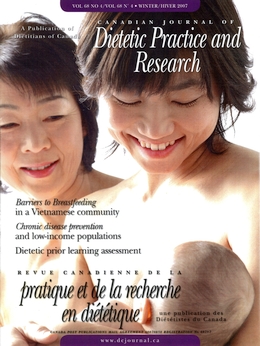Abstract
Purpose: To determine whether fortification allowed older adults in the Kingston, Frontenac, and Lennox & Addington (KFL&A) Public Health area to obtain adequate amounts of food folate, and the proportion at risk of consuming more than the upper limit (UL) of folic acid (1,000 mcg).
Methods: Dietary intake of a convenience sample of 103 healthy, active older adults (age range: 65 to 95 years) was measured using three 24-hour recalls. Dietary folate preand post-fortification was estimated.
Results: Mean dietary folate increased from pre- to postfortification, but 43.4% of women and 20% of men still consumed less than the Estimated Average Requirement of 320 mcg dietary folate equivalent. No intakes exceeded the UL. Participants whose diet met grain products and vegetable and fruit recommendations of Canada's Food Guide to Healthy Eating consumed significantly more folate.
Conclusions: Despite fortification, some older adults in the KFL&A area may not be obtaining enough folate to meet their nutritional needs, and may be at risk for health problems associated with folate deficiency. However, without concomitant serum folate measurements, the proportion is not known. Dietitians need to continue promoting foods naturally rich in folate, along with folic acid-fortified foods. While none of the older adults consumed more than the UL, some could exceed this amount if folic acid supplements were added to a folic acid-rich diet.
Résumé
Objectif: Déterminer si l'enrichissement des aliments a permis à des adultes âgés du secteur de santé publique de Kingston, Frontenac et Lennox & Addington (KFL&A) d'obtenir des quantités adéquates de folate alimentaire et évaluer la proportion de personnes à risque de consommer des quantités dépassant la limite supérieure (LS) d'acide folique (1000 mcg).
Méthodes: L'apport alimentaire d'un échantillon de commodité de 103 adultes âgés (tranche d’âge: 65 à 95 ans) en bonne santé et actifs a été mesuré à l'aide de trois rappels alimentaires de 24 heures. Le folate alimentaire avant et après l'enrichissement a été évalué.
Résultats: Le folate alimentaire moyen a augmenté après l'enrichissement, mais la consommation de 43,4% des femmes et de 20% des hommes restait tout de même inférieure aux besoins estimés moyens de 320 mcg d’équivalents de folate alimentaire. Aucun apport n'excédait la LS. Les participants dont l'alimentation satisfaisait aux recommandations du Guide alimentaire canadien pour manger sainement pour ce qui est des produits céréaliers et des fruits et légumes consommaient significativement plus de folate.
Conclusions: Malgré l'enrichissement, certains adultes âgés du secteur KFL&A peuvent ne pas obtenir suffisamment de folate pour satisfaire à leurs besoins nutritionnels et se trouver à risque de problèmes de santé associés à la carence en folate. Cependant, sans mesure concomitante du folate sérique, on n'en connaît pas la proportion. Les diététistes doivent continuer à promouvoir la consommation d'aliments naturellement riches en folate et d'aliments enrichis en acide folique. Bien que la consommation d'aucun adulte n'ait dépassé la LS, certaines personnes pourraient dépasser cette limite si des suppléments d'acide folique étaient ajoutés à une alimentation déjà riche en acide folique.



